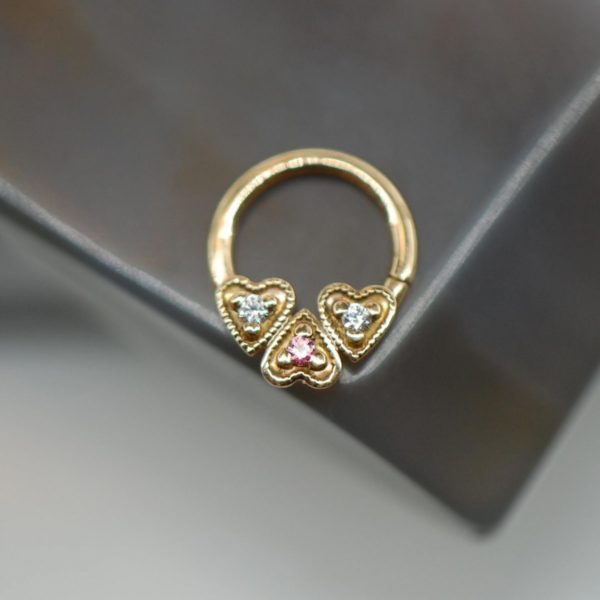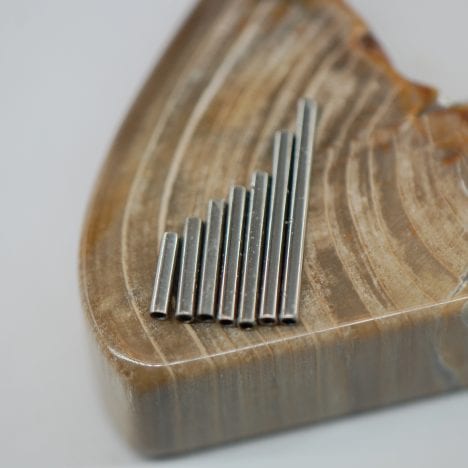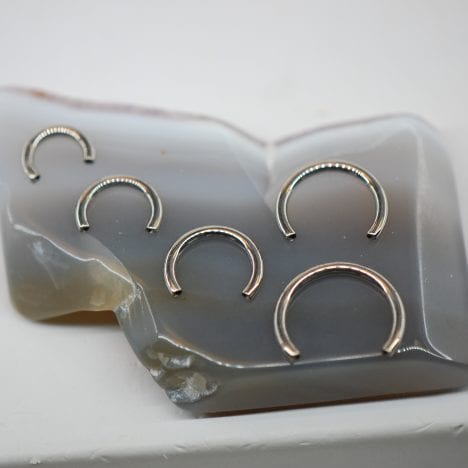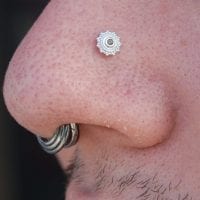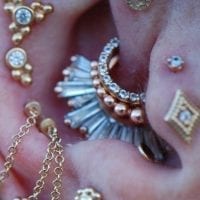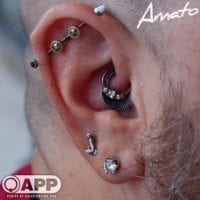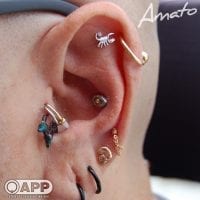Jewelry stacks! This popular piercing trend has been around for centuries, but more recently has been making a resurgence. Stacking is the process of stretching a piercing using multiple rings, giving the ‘stacked’ look. Stacked septums are by far the most common, with stacked helixes close behind. Many piercings are suitable for stacking though, and we even see some bold folks rocking stacked labrets, stacked daiths, stacked rooks and stacked conches. Stacking is a unique method of stretching that allows for a totally one of a kind look. We’re here today to talk all about the ins and outs of stacking, from how its done, how it differs from other stretching methods, and even the jewelry. If you’ve ever considered whether stacking could be for you, keep reading!
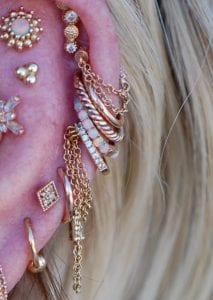
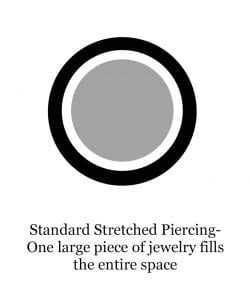
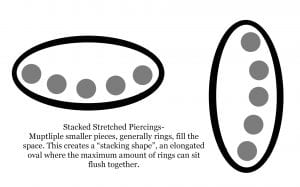
Ultimately, stacking is a form of stretching. The difference in stretching by stacking is that it creates a unique elongated shape to accommodate multiple pieces of jewelry. Traditionally, stretching is done by inserting a single piece of jewelry .5-1mm larger in diameter than what is currently being worn in the piercing, and continuing to do so until the piercing has reached its desired size. For instance, if you are wearing a 5mm piece, you would insert a 6mm piece to stretch. Then, in a few months time, you’d insert a 7mm piece, so on and so forth. (we also have a comprehensive stretching guide which can be found here) Stacking does things a little differently. With stacking you add a ring, typically an 18g, in the same hole as the existing ring, either in front or behind the original jewelry. As it settles, you add another, or switch an existing ring for a slightly thicker one like a 16g (1.2mm) or 14g (1.6mm) piece. Stacking creates an oval shaped piercing hole as opposed to the round shape created by traditional stretching. This oval shape is ideal for stacking as it allows all of the rings to sit perfectly in line with each other, without causing any pressure or irritations. When stacking, it’s extremely important to insert the rings correctly. They should not be crisscrossed over each other, nor should one ring go through another. If this happens it can cause painful pressure and even irritations on the piercings. When inserting the new ring, it should always come either fully in front or fully behind the existing rings. This can be tricky in some piercings so have an experienced piercer assist in inserting jewelry.
To begin stacking, we suggest starting out at anywhere between a 14g-10g for your piercing. That way you can start your stack off right away with 2-3 rings in the hole after the initial piercing has healed. We suggest this instead of adding a ring to an existing 18 or 16g piercing because the bodies’ adjustment to stacking shape can sometimes be uncomfortable. Adjusting to the new shape alongside a fresh stretch is often needlessly uncomfortable as well as runs the risk of damaging the piercing. If the piercing you wish to stretch is a 18 or 16g, we suggest stretching it to a 14g-10g with the traditional method of stretching before starting to stack. Once your piercing is stable and healthy, you can begin by adding the number of rings that fits comfortably. We suggest, like any stretching, waiting 1-3 months in soft tissue and 3-6+ in cartilage between stretches. Generally with a stack, like with a traditional stretch, you can see a small gap when you are ready for your next size. At that time you can insert another ring, or switch one of your current rings for one of a larger gauge.
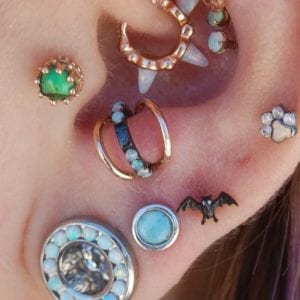
When a new ring is added to a growing stack, something called overstacking will occur. Overstacking is the process of a new ring being added to the stack that then sits slightly above the existing rings rather then perfectly in line with them. Over time the new ring will put pressure on the existing rings, eventually pushing them outwards until the new ring can settle into place. While your stack is in the process of overstacking, the rings may sit at odd angles, and it may feel slightly tender or sore. This is normal, and usually subsides within the first month. Occasionally, stretches may take longer to adjust, or you may need to downsize and wait longer before attempting that size if the piercing remains tender. With traditional stretching, since you are stretching the piercing evenly in all directions, it’s much easier each time you go up. Stacking provides a unique challenge in that the newly added ring can shift in uncomfortably ways, or sit in a way that’s visually unappealing. This is just a side effect of stacking, and something you may just need to accept as you continue to stretch.
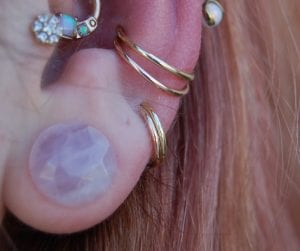
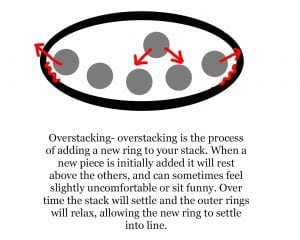
While stacking is a type of stretching, it does not necessarily translate to a traditionally stretched piercing size. Since stacking creates a long ovular shape rather than a round circular shape, a 5mm stack would be 5mm long, but not 5mm tall. The height of that ovular hole will be smaller than its length.- 5mmx 1.5mm or 5mm x 2mm. Now, stretching with a traditional plug (or other round jewelry) creates a perfectly round 5mm hole that is 5mm in every direction. Trying to stack a piercing that was stretched traditionally, you’ll find that it may be uncomfortable even at a larger starting size. Some people are able to easily switch from a stacked shape to a round shape, but we have found a majority of our clients have difficulty or discomfort with this process, which is why we have switched to suggesting stretching via stacking for larger stacks (4+ rings).
This is due to the shape difference. That 5mm round hole may only fit three 1mm rings before the pressure becomes painful. The same is true in the inverse- you’ll find you can’t insert a 5mm round plug into a stacked piercing that wears 5mm of rings because the stacked piercing is an oval shape, and can only really fit perhaps a 2mm or 2.5mm round plug. In light of this, we encourage anyone who may be interested in stacking to decide early on if what they want is a stacked piercing or a stretched piercing. There are many challenges when switching from one to the other and it’s generally much easier to stretch with your desired look in mind.
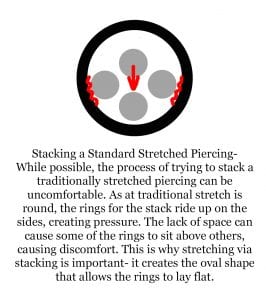
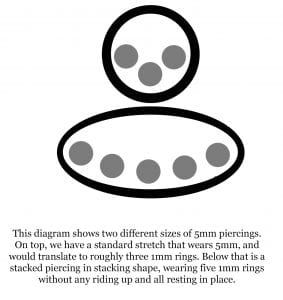
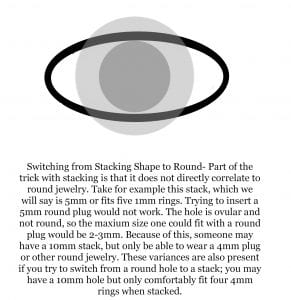
There are multiple piercings that are able to be stacked, but septums are the ideal and most common piercing for stacking. The soft cartilage they are generally pierced into adjusts to the oval shape quite nicely, and stacking also often prevents the dreaded septum dent when stretching. (Septum denting is a common occurrence when stretching your septum with a round piece of jewelry. Eventually, the jewelry will rub on the harder, structural cartilage and can sometimes even erode it) Helixes are also popular to stack, and while it requires more patience, it’s a fun and interesting look. Other, more uncommon piercings have been stacked (like daiths or rooks) however stacking those kinds of piercings is a relatively new thing, and not much information exists about it. If this is something you want to try, we encourage you to work closely with a piercer experienced in stacking, and to understand this is a unconventional process and it may take some time and troubleshooting. A skilled piercer can also direct you to the best course of action. While stretching via stacking is one way to get this unique look, depending on your goals other procedures such a coin slots or punched cartilage may be a better bet for you. Your piercer can help you decide which path is the right one.
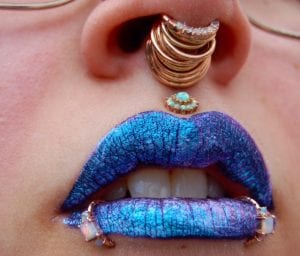
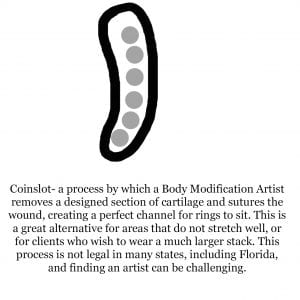
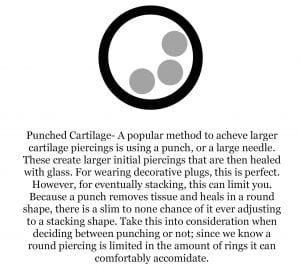
Jewelry for stacking is generally rings, leaving you with a few choices. The most common are seam rings and clickers. While you can stack with captive bead rings, some people find that the constant movement of the bead can be irritating. Likewise, you can stretch with segment rings, but inserting and removing them will almost certainly require a second person. Seam rings are rings that twist open and closed, and often have one rounded end called a cup that help secure the seam together. This can act like the rounded back of a single flare plug, and work well for stretching. Seam rings are also very secure, and you never need to worry about them falling our or losing them. Their downside though is that once your stack reaches a certain point however, seam rings can become tricky to install and remove on your own. They also MUST be closed correctly, any gap or space in the seam can damage and irritate the piercing. They don’t permit for easy changing and switching of a stack, which can make them limiting. Clickers are rings with a hinge that are very easy to open and close. These pieces are great for stacking, especially when you already have a stack with multiple rings, because of their ease of insertion and removal. They make it possible to change and switch your stack regularly on your own, and are also easy to take in and out to clean the pieces. The con to clickers is that they are frequently made with a small pin on one end that allows the hinge to close securely, but can be scratchy which can make stretching directly with a clicker uncomfortable. Clickers are also sometimes slightly more expensive because of the delicate hinges, and you should check from time to time to ensure they are secure.
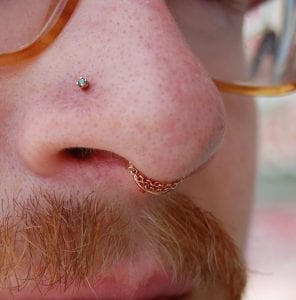
Stacking is a very unique method to stretch, and the information is constantly growing and improving, plus it’s one of our favorites here. Please stop by, call, or email to discuss stacking with any of our trained staff!
